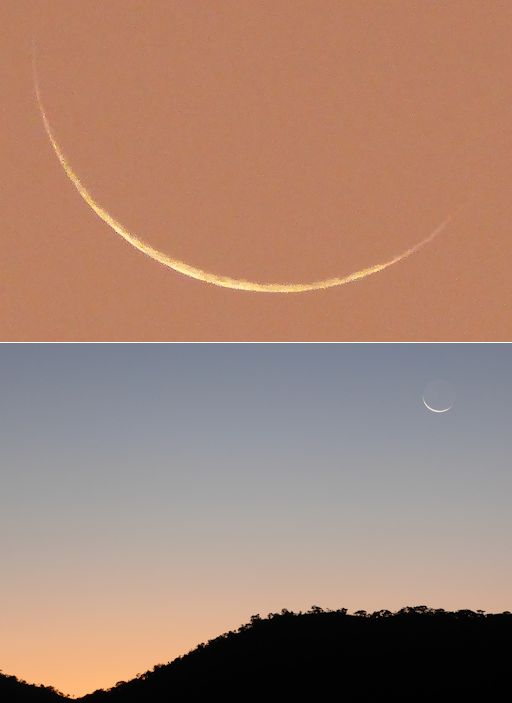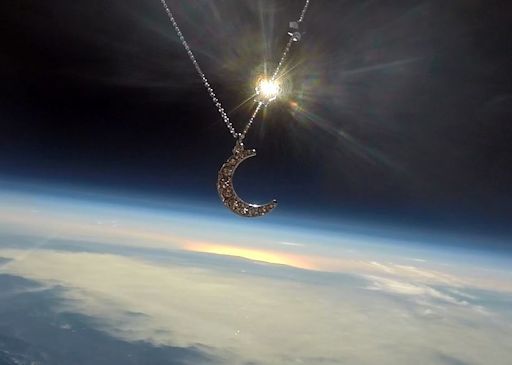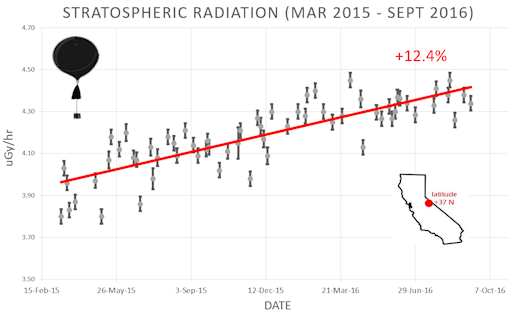 | | | Switch to: Europe, USA, New Zealand, Antarctica Credit: NOAA/Ovation  Planetary K-index Planetary K-index
Now: Kp= 1 quiet
24-hr max: Kp= 2 quiet
explanation | more data
Interplanetary Mag. Field
Btotal: 5.0 nT
Bz: -2.1 nT south
more data: ACE, DSCOVR
Updated: Today at 2346 UT  Coronal Holes: 28 Apr 17 Coronal Holes: 28 Apr 17 
There are no large coronal holes on the Earth side of the sun. Credit: NASA/SDO.  Noctilucent Clouds The southern season for noctilucent clouds began on Nov. 17, 2016. Come back to this spot every day to see the "daily daisy" from NASA's AIM spacecraft, which is monitoring the dance of electric-blue around the Antarctic Circle. Switch view: Ross Ice Shelf, Antarctic Peninsula, East Antarctica, Polar Updated at: 02-24-2017 17:55:02 Noctilucent Clouds The southern season for noctilucent clouds began on Nov. 17, 2016. Come back to this spot every day to see the "daily daisy" from NASA's AIM spacecraft, which is monitoring the dance of electric-blue around the Antarctic Circle. Switch view: Ross Ice Shelf, Antarctic Peninsula, East Antarctica, Polar Updated at: 02-24-2017 17:55:02  SPACE WEATHER
NOAA Forecasts | | Updated at: 2017 Apr 28 2200 UTC FLARE | 0-24 hr | 24-48 hr | CLASS M | 01 % | 01 % | CLASS X | 01 % | 01 % |  Geomagnetic Storms: Geomagnetic Storms:
Probabilities for significant disturbances in Earth's magnetic field are given for three activity levels: active, minor storm, severe storm Updated at: 2017 Apr 28 2200 UTC Mid-latitudes | 0-24 hr | 24-48 hr | ACTIVE | 05 % | 10 % | MINOR | 01 % | 05 % | SEVERE | 01 % | 01 % | High latitudes | 0-24 hr | 24-48 hr | ACTIVE | 15 % | 15 % | MINOR | 15 % | 20 % | SEVERE | 10 % | 20 % | | | |  | | | | | | | | | | | Looking for a far-out Mother's Day gift? Find something truly out of this world in the Earth to Sky Store. Space roses, Cosmic Reindeer, Arctic space pendants, and more! | | | LONG RANGE FORECAST: NOAA forecasters say that G2-class geomagnetic storms are possible on May 19-20 when a solar wind stream is expected to hit Earth's magnetic field. This is the same stream that hit Earth on April 24-25, sparking bright auroras around both poles. In May, it will return for another lashing as the sun's rotation turns the underlying coronal hole back toward our planet. Free: Aurora Alerts CRESCENT SUPERMOON: If you thought last night's crescent Moon was super-beautiful, you were right. It was a crescent supermoon. Peter Lowenstein photographed the slender arc from Mutare, Zimbabwe: 
"The evening sky was perfectly clear and allowed a good view of the very young crescent supermoon," says Lowenstein. "At first the thin crescent was difficult to locate above the sunset glare (first picture) but as the orange light faded and the sky turned turned lilac and then blue it became clearly visible to the north of Christmas Pass." What made the crescent "super"? Anyone reading NASA press releases in recent years has heard of "supermoons"--full Moons that are extra big and bright because they occur on the perigee side of the Moon's elliptical orbit. Last night's sky show was the same phenomenon, writ slender. The crescent Moon of April 27th occurred at perigee, making it as much as 14% wider and 30% brighter than other crescent Moons of the year. Realtime Space Weather Photo Gallery THESE PENDANTS HAVE TOUCHED SPACE: These pendants have touched space--and returned to Earth in time for Mother's Day. To support their cosmic ray monitoring program, the students of Earth to Sky Calculus flew a payload-full of jewelry to the stratosphere onboard a high-altitude helium balloon. Here's one of the pendants 113,200 feet above the Sierras of central California: 
These necklaces make great Mother's Day gifts--and you have have one for $89.95. Each glittering pendant comes with a greeting card showing the jewelry in flight and telling the story of its journey to the stratosphere and back again. More far-out Mother's Day gifts may be found in the Earth to Sky Store. All proceeds support atmospheric radiation monitoring and hands-on STEM education. Realtime Aurora Photo Gallery
Realtime Comet Photo Gallery Every night, a network of NASA all-sky cameras scans the skies above the United States for meteoritic fireballs. Automated software maintained by NASA's Meteoroid Environment Office calculates their orbits, velocity, penetration depth in Earth's atmosphere and many other characteristics. Daily results are presented here on Spaceweather.com. On Apr. 28, 2017, the network reported 0 fireballs.
(0 sporadics)  In this diagram of the inner solar system, all of the fireball orbits intersect at a single point--Earth. The orbits are color-coded by velocity, from slow (red) to fast (blue). [Larger image] [movies] Potentially Hazardous Asteroids ( PHAs) are space rocks larger than approximately 100m that can come closer to Earth than 0.05 AU. None of the known PHAs is on a collision course with our planet, although astronomers are finding new ones all the time. On April 28, 2017 there were 1799 potentially hazardous asteroids.  | Recent & Upcoming Earth-asteroid encounters: | Asteroid | Date(UT) | Miss Distance | Velocity (km/s) | Diameter (m) | | 2017 HW2 | 2017-Apr-27 | 9.2 LD | 9.1 | 18 | | 2017 FE157 | 2017-Apr-29 | 18.4 LD | 8.6 | 63 | | 2017 HK1 | 2017-May-05 | 16.9 LD | 2.6 | 38 | | 2015 VD1 | 2017-May-07 | 18.2 LD | 10.5 | 34 | | 2012 EC | 2017-May-16 | 19.5 LD | 4.5 | 74 | | 2017 CS | 2017-May-29 | 8 LD | 9.1 | 468 | | 418094 | 2017-Jun-01 | 8 LD | 23.2 | 490 | | 2010 VB1 | 2017-Jun-16 | 10.3 LD | 8.3 | 81 | | 471984 | 2017-Jun-18 | 19.1 LD | 7.7 | 102 | Notes: LD means "Lunar Distance." 1 LD = 384,401 km, the distance between Earth and the Moon. 1 LD also equals 0.00256 AU. MAG is the visual magnitude of the asteroid on the date of closest approach. | | Cosmic Rays in the Atmosphere |
Readers, thank you for your patience while we continue to develop this new section of Spaceweather.com. We've been working to streamline our data reduction, allowing us to post results from balloon flights much more rapidly, and we have developed a new data product, shown here: 
This plot displays radiation measurements not only in the stratosphere, but also at aviation altitudes. Dose rates are expessed as multiples of sea level. For instance, we see that boarding a plane that flies at 25,000 feet exposes passengers to dose rates ~10x higher than sea level. At 40,000 feet, the multiplier is closer to 50x. These measurements are made by our usual cosmic ray payload as it passes through aviation altitudes en route to the stratosphere over California. What is this all about? Approximately once a week, Spaceweather.com and the students of Earth to Sky Calculus fly space weather balloons to the stratosphere over California. These balloons are equipped with radiation sensors that detect cosmic rays, a surprisingly "down to Earth" form of space weather. Cosmic rays can seed clouds, trigger lightning, and penetrate commercial airplanes. Furthermore, there are studies ( #1, #2, #3, #4) linking cosmic rays with cardiac arrhythmias and sudden cardiac death in the general population. Our latest measurements show that cosmic rays are intensifying, with an increase of more than 12% since 2015: 
Why are cosmic rays intensifying? The main reason is the sun. Solar storm clouds such as coronal mass ejections (CMEs) sweep aside cosmic rays when they pass by Earth. During Solar Maximum, CMEs are abundant and cosmic rays are held at bay. Now, however, the solar cycle is swinging toward Solar Minimum, allowing cosmic rays to return. Another reason could be the weakening of Earth's magnetic field, which helps protect us from deep-space radiation. The radiation sensors onboard our helium balloons detect X-rays and gamma-rays in the energy range 10 keV to 20 MeV. These energies span the range of medical X-ray machines and airport security scanners. The data points in the graph above correspond to the peak of the Reneger-Pfotzer maximum, which lies about 67,000 feet above central California. When cosmic rays crash into Earth's atmosphere, they produce a spray of secondary particles that is most intense at the entrance to the stratosphere. Physicists Eric Reneger and Georg Pfotzer discovered the maximum using balloons in the 1930s and it is what we are measuring today. | | The official U.S. government space weather bureau | | | The first place to look for information about sundogs, pillars, rainbows and related phenomena. | | | Researchers call it a "Hubble for the sun." SDO is the most advanced solar observatory ever. | | | 3D views of the sun from NASA's Solar and Terrestrial Relations Observatory | | | Realtime and archival images of the Sun from SOHO. | | | from the NOAA Space Environment Center | | | a proud supporter of science education and Spaceweather.com | | | fun to read, but should be taken with a grain of salt! Forecasts looking ahead more than a few days are often wrong. | | | from the NOAA Space Environment Center | | | the underlying science of space weather |  | Beautyz for top beauty products reviews and their buying guides |  | Reviews here can help you to pick up best memory foam mattresses. | | | These links help Spaceweather.com stay online. Thank you to our supporters! | | | | | | | | |  | |  |   | ©2016 Spaceweather.com. All rights reserved. This site is penned daily by Dr. Tony Phillips. | |

